It’s August, and thoughts are turning to the beginning of a new school year. This week’s column includes reviews of picture books about first-day-of-school expectations and experiences that are good read-aloud choices for younger children and novels about navigating the ins and outs and ups and downs of middle and secondary school for older readers.
Ages 4–8
All Are Welcome. Alexandra Penfold. Ill. Suzanne Kaufman. 2018. Knopf/Random House.
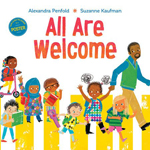 Reading aloud this picture book is the perfect way to welcome all children into the classroom at the start of the school year. Lyrical stanzas with the repeated refrain “All are welcome here,” combined with colorful illustrations (created using acrylic paint, ink, crayon and collage with Photoshop) featuring a diverse array of children, parents, and teachers, reassure young children that school is a safe, welcoming place for everyone. A final double gatefold showcases a joyful school community celebration. “You have a place here. / You have a space here. / You are welcome here.”
Reading aloud this picture book is the perfect way to welcome all children into the classroom at the start of the school year. Lyrical stanzas with the repeated refrain “All are welcome here,” combined with colorful illustrations (created using acrylic paint, ink, crayon and collage with Photoshop) featuring a diverse array of children, parents, and teachers, reassure young children that school is a safe, welcoming place for everyone. A final double gatefold showcases a joyful school community celebration. “You have a place here. / You have a space here. / You are welcome here.”
Dear Substitute. Liz Garton Scanlon & Audrey Vernick. Ill. Chris Raschka. 2018. Disney Hyperion.
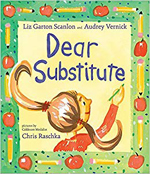 “Dear Substitute, / Wow. This is a surprise. / What are you doing here? / Where’s Mrs. Giordano, / and why didn’t she warn us?” Through a series of short letters written by a young girl, readers sense her frustration with the substitute teacher, who does not follow established daily routine and procedures. She doesn’t pronounce the student’s names correctly, they don’t clean out the class turtle’s tank even though it’s “Tank Tuesday,” and she doesn’t collect the homework. But she does read aloud some funny poems during an extra storytime, during which the girl discovers that she likes poetry. Chris Raschka’s colorful watercolor and gouache illustrations playfully portray the girl’s changing moods as she realizes that having a day or two with a substitute who mixes things up a bit is okay.
“Dear Substitute, / Wow. This is a surprise. / What are you doing here? / Where’s Mrs. Giordano, / and why didn’t she warn us?” Through a series of short letters written by a young girl, readers sense her frustration with the substitute teacher, who does not follow established daily routine and procedures. She doesn’t pronounce the student’s names correctly, they don’t clean out the class turtle’s tank even though it’s “Tank Tuesday,” and she doesn’t collect the homework. But she does read aloud some funny poems during an extra storytime, during which the girl discovers that she likes poetry. Chris Raschka’s colorful watercolor and gouache illustrations playfully portray the girl’s changing moods as she realizes that having a day or two with a substitute who mixes things up a bit is okay.
School People. Lee Bennett Hopkins (Ed.). Ill. Ellen Shi. 2018. WordSong/Highlights.
 This collection of 15 poems selected by Lee Bennett Hopkins begins with Rebecca Kai Dotlich’s “School Story,” in which the school building itself extends a welcome to students: “I am waiting—come on in!” The following entries by other children’s poets introduce elementary school personnel—a bus driver, crossing guard, principal, lunch lady, custodian, nurse, coach, librarian, and various teachers and specialists—before ending with a second poem by Dotlich from the school’s point of view: “School’s Story Reprise.” Ellen Shi portrays diversity among students, their families, and “school people” in her colorful, digitally created artwork, which complements this welcome-to-school anthology of poetry.
This collection of 15 poems selected by Lee Bennett Hopkins begins with Rebecca Kai Dotlich’s “School Story,” in which the school building itself extends a welcome to students: “I am waiting—come on in!” The following entries by other children’s poets introduce elementary school personnel—a bus driver, crossing guard, principal, lunch lady, custodian, nurse, coach, librarian, and various teachers and specialists—before ending with a second poem by Dotlich from the school’s point of view: “School’s Story Reprise.” Ellen Shi portrays diversity among students, their families, and “school people” in her colorful, digitally created artwork, which complements this welcome-to-school anthology of poetry.
The Secrets of Ninja School. Deb Pilutti. 2018. Christy Ottaviano/Henry Holt.
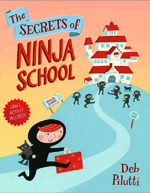 When Ruby goes to Ninja School, she is not as stealthy and skilled as the other young ninjas (or saplings). She’s worried she doesn’t have her own secret skill that Master Willow says each ninja possesses. But one night, when all the saplings are feeling homesick, Ruby discovers her secret talents in storytelling, making things, and being a good friend. Readers will be reminded that everyone has special gifts and talents and they don't need to all be good at the same things. Cartoon-style illustrations, created in gouache and pen and ink, add to the fun of reading this ninja school story. Back matter includes a pattern and step-by-step instructions that young readers can use to make their own dragon from felt or paper, just like the one Ruby made for her friends.
When Ruby goes to Ninja School, she is not as stealthy and skilled as the other young ninjas (or saplings). She’s worried she doesn’t have her own secret skill that Master Willow says each ninja possesses. But one night, when all the saplings are feeling homesick, Ruby discovers her secret talents in storytelling, making things, and being a good friend. Readers will be reminded that everyone has special gifts and talents and they don't need to all be good at the same things. Cartoon-style illustrations, created in gouache and pen and ink, add to the fun of reading this ninja school story. Back matter includes a pattern and step-by-step instructions that young readers can use to make their own dragon from felt or paper, just like the one Ruby made for her friends.
Twig. Aura Parker. 2018. Simon & Schuster.
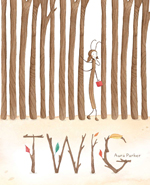 It is Heidi’s first day at Bug School, but as a stick insect, “tall and long like the twig of a tree,” she blends right in with the surroundings and no one notices her—not even Miss Orb, the teacher! When one of the students picks Heidi up to use in a weaving project, she finally speaks up and yells, “I’m NOT a twig! I’m me! I’m Heidi!” Miss Orb welcomes Heidi to the class, and all the students work together to weave a scarf to help Heidi stand out. Parker’s illustrations (rendered in watercolor, colored pencil, and artline pens) bring a soft, whimsical feel to this first-day-of-school story. Readers are challenged to identify various “bugs” (insects and spiders)—14 honeybees, one tarantula, 12 fire ants, and others—on the detailed endpapers.
It is Heidi’s first day at Bug School, but as a stick insect, “tall and long like the twig of a tree,” she blends right in with the surroundings and no one notices her—not even Miss Orb, the teacher! When one of the students picks Heidi up to use in a weaving project, she finally speaks up and yells, “I’m NOT a twig! I’m me! I’m Heidi!” Miss Orb welcomes Heidi to the class, and all the students work together to weave a scarf to help Heidi stand out. Parker’s illustrations (rendered in watercolor, colored pencil, and artline pens) bring a soft, whimsical feel to this first-day-of-school story. Readers are challenged to identify various “bugs” (insects and spiders)—14 honeybees, one tarantula, 12 fire ants, and others—on the detailed endpapers.
Ages 9–11
Class Action. Steven B. Frank. 2018. Houghton Mifflin.
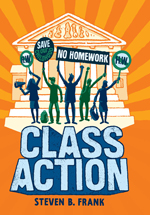 When sixth grader Sam takes a stand against homework, he finds himself in trouble with his parents and the school. During his three-day suspension for refusing to do homework, Sam gets to know his feisty elderly neighbor, Mr. Kalman, and discovers that this retired lawyer might just be the person he needs to help him. With the assistance of his older sister Sadie and the support of a group of Sam’s sixth-grade friends, Sam and Mr. Kalman take on homework in a class action lawsuit against the Los Angeles School Board that goes all the way to the U.S. Supreme Court. This humorous story will appeal to middle schoolers (and teachers) who appreciate the art of a finely crafted argument. Back matter includes a glossary of legal terms used in the novel.
When sixth grader Sam takes a stand against homework, he finds himself in trouble with his parents and the school. During his three-day suspension for refusing to do homework, Sam gets to know his feisty elderly neighbor, Mr. Kalman, and discovers that this retired lawyer might just be the person he needs to help him. With the assistance of his older sister Sadie and the support of a group of Sam’s sixth-grade friends, Sam and Mr. Kalman take on homework in a class action lawsuit against the Los Angeles School Board that goes all the way to the U.S. Supreme Court. This humorous story will appeal to middle schoolers (and teachers) who appreciate the art of a finely crafted argument. Back matter includes a glossary of legal terms used in the novel.
The 11:11 Wish. Kim Tomsic. 2018. Katherine Tegen/HarperCollins.
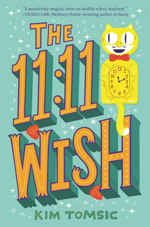 Megan Meyers is starting seventh grade in a new school. She’s moved from Colorado to Arizona with her dad and younger sister, Piper, following her mom’s death. All Megan wants is to make some new friends. So, when she finds herself smack dab in the middle of a friendship rivalry and saddled with a dare to “make something exciting happen,” on her first day at school, making a wish on a cat clock in her history classroom at exactly 11:11 doesn’t seem like such a terrible idea. When the wish comes true and Megan finds herself unsure of how to deal with her new magical powers, she must decide if the consequences of using magic are worth the reward. This humorous story about making new friends, finding your voice, and second chances will appeal to middle school students, particularly fans of magical realism.
Megan Meyers is starting seventh grade in a new school. She’s moved from Colorado to Arizona with her dad and younger sister, Piper, following her mom’s death. All Megan wants is to make some new friends. So, when she finds herself smack dab in the middle of a friendship rivalry and saddled with a dare to “make something exciting happen,” on her first day at school, making a wish on a cat clock in her history classroom at exactly 11:11 doesn’t seem like such a terrible idea. When the wish comes true and Megan finds herself unsure of how to deal with her new magical powers, she must decide if the consequences of using magic are worth the reward. This humorous story about making new friends, finding your voice, and second chances will appeal to middle school students, particularly fans of magical realism.
Totally Middle School: Tales of Friends, Family, and Fitting In.Betsy Groban (Ed.). 2018. Delacorte/Random House.
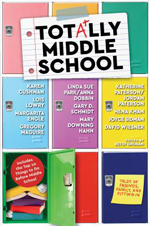 This collection of stories by well-known authors—Lois Lowry, Margarita Engle, Katherine Paterson, Linda Sue Park, David Wiesner, and six others—includes middle school-themed stories in a variety of formats. For example, Joyce Sidman’s “Ode to the Band Room” is a short poem told from the perspective of the band room before the arrival of students; “Dog People,” by Linda Sue Park and her daughter Anna Dobbin, tells a story about what it’s like to be a first-time middle schooler from the perspectives of a young girl and her dog; and in “Middle School,” David Wiesner offers a short graphic memoir of his own middle school experiences. Each tale is followed by a brief, personalized biographical note on the writer.
This collection of stories by well-known authors—Lois Lowry, Margarita Engle, Katherine Paterson, Linda Sue Park, David Wiesner, and six others—includes middle school-themed stories in a variety of formats. For example, Joyce Sidman’s “Ode to the Band Room” is a short poem told from the perspective of the band room before the arrival of students; “Dog People,” by Linda Sue Park and her daughter Anna Dobbin, tells a story about what it’s like to be a first-time middle schooler from the perspectives of a young girl and her dog; and in “Middle School,” David Wiesner offers a short graphic memoir of his own middle school experiences. Each tale is followed by a brief, personalized biographical note on the writer.
Ages 12–14
Lights, Camera, Disaster. Erin Dionne. 2018. Arthur A. Levine/Scholastic.
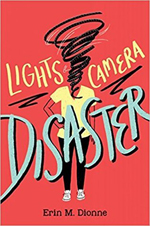 To begin the year in an unexpected way, read this novel about the end of the school year in which Hester Greene is in danger of not passing eighth grade if she fails English class. Dealing with executive functioning disorder, Hester knows her weaknesses (lack of organization, failure to complete homework, and inability to stay focused on the task at hand) and her strength and passion (the art of movie making). When her parents take away her beloved video camera as punishment for failing yet another English test, Hester is forced to take stock of her life and decisions and figure out how to harness her strengths. Hester asks herself, how would I direct this story differently? Would I let this stuff happen again? Readers are reminded that their successes—and failures—lie in their own hands.
To begin the year in an unexpected way, read this novel about the end of the school year in which Hester Greene is in danger of not passing eighth grade if she fails English class. Dealing with executive functioning disorder, Hester knows her weaknesses (lack of organization, failure to complete homework, and inability to stay focused on the task at hand) and her strength and passion (the art of movie making). When her parents take away her beloved video camera as punishment for failing yet another English test, Hester is forced to take stock of her life and decisions and figure out how to harness her strengths. Hester asks herself, how would I direct this story differently? Would I let this stuff happen again? Readers are reminded that their successes—and failures—lie in their own hands.
The Miscalculations of Lightning Girl. Stacy McAnulty. 2018. Random House.
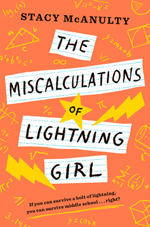 When she was 8 years old, Lucy Callahan was struck by lightning, causing brain damage resulting in acquired savant syndrome and obsessive-compulsive disorder. After spending the last four years being homeschooled by her grandmother, taking advanced math courses, and chatting with other math enthusiasts online, 12-year-old Lucy is ready for college, but instead is enrolled in the local public middle school by her Nana, who challenges her to attend for one year, make one friend, read one book not about math, and try one new activity. Lucy gives it a go and discovers that, while middle school is not her favorite place in the world, it’s also not quite as terrible as she imagined it to be. Back matter for this engaging school story includes facts about Pi and the Fibonacci sequence for math lovers like Lucy.
When she was 8 years old, Lucy Callahan was struck by lightning, causing brain damage resulting in acquired savant syndrome and obsessive-compulsive disorder. After spending the last four years being homeschooled by her grandmother, taking advanced math courses, and chatting with other math enthusiasts online, 12-year-old Lucy is ready for college, but instead is enrolled in the local public middle school by her Nana, who challenges her to attend for one year, make one friend, read one book not about math, and try one new activity. Lucy gives it a go and discovers that, while middle school is not her favorite place in the world, it’s also not quite as terrible as she imagined it to be. Back matter for this engaging school story includes facts about Pi and the Fibonacci sequence for math lovers like Lucy.
Ages 15+
American Panda. Gloria Chao. 2018. Simon Pulse/Simon & Schuster.
 Mei is a Taiwanese American freshman at the Massachusetts Institute of Technology, who is starting college a year early because she skipped fourth grade. Her demanding and overly protective Taiwanese immigrant parents desperately want her to become a doctor and to marry a Taiwanese boy, but Mei hates germs and she finds herself attracted to a boy her parents disapprove of. When they cut Mei off financially after she tries to discuss alternative plans for her future with them, she must come to terms with the consequences of her decisions. This is a coming-of-age novel about family, finding your way, and making your own choices.
Mei is a Taiwanese American freshman at the Massachusetts Institute of Technology, who is starting college a year early because she skipped fourth grade. Her demanding and overly protective Taiwanese immigrant parents desperately want her to become a doctor and to marry a Taiwanese boy, but Mei hates germs and she finds herself attracted to a boy her parents disapprove of. When they cut Mei off financially after she tries to discuss alternative plans for her future with them, she must come to terms with the consequences of her decisions. This is a coming-of-age novel about family, finding your way, and making your own choices.
How We Roll. Natasha Friend. 2018. Farrar, Straus and Giroux.
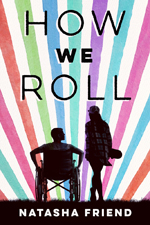 When her family moves from Colorado to Massachusetts so that her younger brother Julian can attend a school for children with special needs, high school freshman Quinn sees this as an opportunity for a fresh start with friends who don’t know that she has alopecia, a medical condition that causes complete hair loss. She starts at her new high school with a new wig and a new attitude, hoping to keep her alopecia a secret. It isn’t long before she befriends Nick, a former star quarterback, who lost both of his legs in a snowmobile accident the year before. Together, they come to terms with what makes them different in this novel that combines a light romance with themes of friendship, family, starting over, and self-discovery.
When her family moves from Colorado to Massachusetts so that her younger brother Julian can attend a school for children with special needs, high school freshman Quinn sees this as an opportunity for a fresh start with friends who don’t know that she has alopecia, a medical condition that causes complete hair loss. She starts at her new high school with a new wig and a new attitude, hoping to keep her alopecia a secret. It isn’t long before she befriends Nick, a former star quarterback, who lost both of his legs in a snowmobile accident the year before. Together, they come to terms with what makes them different in this novel that combines a light romance with themes of friendship, family, starting over, and self-discovery.
Jennifer W. Shettel is a professor at Millersville University of Pennsylvania, where she teaches undergraduate and graduate course in literacy education for pre-service and practicing teachers. Prior to joining the faculty at Millersville, she spent 16 years as an elementary classroom teacher and reading specialist in the public schools.
These reviews are submitted by members of the International Literacy Association's Children's Literature and Reading Special Interest Group (CL/R SIG) and are published weekly on Literacy Daily.